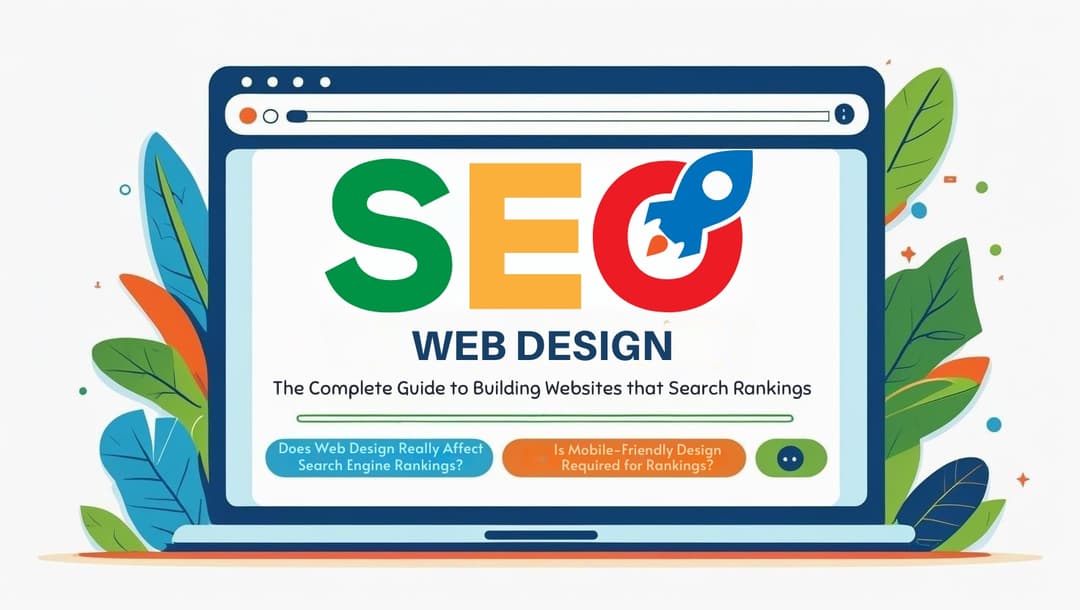Support center (714) 707-2483
SEO Web Design: The Complete Guide to Building Websites That Dominate Search Rankings
The reality: Your website's design directly impacts whether you rank on Google's first page or disappear into the digital void. Here's exactly how design decisions shape your search visibility.

Does Web Design Really Affect Search Engine Rankings?
Absolutely. Search engines evaluate how users interact with your site, and design elements like page load time, mobile-friendliness, and navigation structure directly influence these user behavior signals. When visitors quickly leave your site due to poor design, Google interprets this as a quality signal and lowers your rankings accordingly.
Modern search algorithms don't just analyze content—they evaluate the complete user experience your website provides.
How Fast Should My Website Load for Good Rankings?
Page speed is now a confirmed ranking factor. A 100-millisecond delay in load time can decrease conversions by 7%, and users will abandon sites that take more than a few seconds to load. For optimal search performance:
- Target under 2.5 seconds for initial content loading
- Aim for under 100 milliseconds for user interaction response
- Optimize images to under 55KB using WebP format
- Implement lazy loading for off-screen content
Search engines monitor these metrics through Core Web Vitals, making speed optimization essential for ranking success.
Is Mobile-Friendly Design Required for Rankings?
Yes, mobile optimization is mandatory. Currently, 58.67% of global website traffic comes from mobile devices, and Google uses mobile-first indexing exclusively. This means Google only considers your mobile version when determining rankings.
Key mobile requirements include:
- Responsive design that adapts to all screen sizes
- Touch-friendly navigation with adequate spacing
- Readable text without requiring zoom
- Fast mobile loading optimized for slower connections
Without mobile optimization, your site cannot achieve competitive rankings regardless of content quality.
What Design Elements Hurt Search Rankings Most?
Several design choices actively damage your search performance:
Slow Loading Elements:
- Unoptimized images and videos
- Excessive plugins and widgets
- Bloated code from pre-built themes
Navigation Problems:
- Complex menu structures
- Broken internal links
- Poor URL organization
User Experience Issues:
- Intrusive pop-ups and ads
- Difficult-to-read fonts
- Inconsistent design across pages
Google monitors behavior metrics like time on page, bounce rates, and engagement levels as ranking signals, so design problems that frustrate users directly impact search visibility.
How Does Website Navigation Impact Rankings?
Navigation structure affects both user experience and search engine crawling ability. Clear, intuitive navigation keeps visitors on your site longer and reduces bounce rates, which are essential factors for search rankings.
Effective navigation includes:
- Logical hierarchy that reflects content importance
- Descriptive menu labels that help users and search engines understand page content
- Internal linking strategy that distributes authority throughout your site
- Breadcrumb navigation for easy orientation
Search engines use your navigation structure to understand your site's organization and determine which pages deserve ranking priority.
Can Poor Design Override Good Content?
Unfortunately, yes. Even high-quality content will underperform if presented within poor design, as 38% of users will leave a site if they don't like the design. Search engines interpret rapid user departures as quality signals, potentially lowering rankings despite excellent content.
The most successful approach combines quality content with strategic design that:
- Enhances content readability through proper formatting
- Guides users to relevant information efficiently
- Encourages engagement through intuitive interaction design
- Builds trust through professional presentation
Does Website Redesign Affect Current Rankings?
Redesigning can impact rankings, but the effect depends on implementation approach. Minor visual changes like updating logos, images, or colors typically have little to no effect on rankings. However, major structural changes require careful planning to preserve search performance.
Low-Risk Changes:
- Visual styling updates
- Image replacements
- Logo modifications
- Color scheme adjustments
High-Risk Changes:
- URL structure modifications
- Navigation reorganization
- Page deletion or consolidation
- Technical architecture changes
Proper SEO web design during redesigns maintains ranking strength while improving user experience.
What Technical Elements Are Essential for Rankings?
Several behind-the-scenes design elements directly affect search performance:
Clean Code Structure:
- Semantic HTML that search engines can easily interpret
- Minimal, efficient CSS and JavaScript
- Proper heading hierarchy (H1-H6)
URL Architecture:
- Logical, keyword-rich URLs
- Consistent structure across the site
- Proper canonicalization
Technical Optimizations:
- SSL certificate implementation
- XML sitemap creation
- Robots.txt configuration
- Schema markup integration
These elements form the foundation that enables search engines to understand and rank your content effectively.
How Do Images Affect Search Rankings?
Images significantly impact both user experience and search performance when optimized correctly. Properly optimized images help pages load quickly and improve overall user engagement.
Image optimization best practices:
- Descriptive filenames that include relevant keywords
- Alt text that describes image content for accessibility
- Appropriate file formats (WebP for photographs, SVG for graphics)
- Compressed file sizes without quality loss
- Responsive sizing for different device screens
Well-optimized images can also appear in image search results, creating additional traffic opportunities.
Does Visual Design Quality Impact Rankings?
Visual appeal indirectly affects rankings through user behavior signals. Professional, trustworthy design encourages users to:
- Stay longer on your website
- Explore more pages during their visit
- Return for future visits
- Share your content with others
Search engines interpret these positive engagement signals as quality indicators, potentially boosting rankings for sites that provide superior user experiences.
How Important Is Consistent Design Across Pages?
Design consistency helps both users and search engines navigate your site effectively. Layout consistency should be maintained throughout the website to ensure users can find what they are looking for quickly and efficiently.
Consistent design elements include:
- Navigation placement and functionality
- Content formatting and structure
- Visual hierarchy and typography
- Interactive elements and behaviors
This consistency helps search engines understand your site structure and helps users develop familiarity with your interface.
What Role Does User Experience Play in Rankings?
User experience (UX) has become central to search engine evaluation. Search engines like Google increasingly emphasize UX elements as critical ranking factors because they aim to provide users with the most helpful and satisfying results.
Key UX factors affecting rankings:
- Intuitive navigation that helps users find information quickly
- Clear content hierarchy that guides attention appropriately
- Accessible design that works for users with disabilities
- Engaging interactions that encourage exploration
Modern SEO web design prioritizes user satisfaction as the path to search engine success.
How Can Small Businesses Compete with Better-Designed Sites?
Focus on fundamental design principles rather than expensive features:
Priority Improvements:
- Optimize page speed through image compression and code cleanup
- Ensure mobile responsiveness across all pages
- Create clear navigation that helps users find information quickly
- Improve content readability through better formatting
Cost-Effective Strategies:
- Use proven design patterns rather than custom solutions
- Focus on performance over visual complexity
- Prioritize user needs over aesthetic preferences
- Test changes systematically to measure impact
Small improvements in core design elements often produce significant ranking improvements.
What Should I Avoid When Designing for Search?
Common design mistakes that hurt rankings:
Performance Killers:
- Auto-playing videos and audio
- Excessive animation and effects
- Unoptimized third-party plugins
- Oversized images and files
Navigation Problems:
- Hidden or unclear menu systems
- Broken internal links
- Inconsistent URL structures
- Missing breadcrumb navigation
User Experience Issues:
- Intrusive pop-ups and interstitials
- Difficult-to-read typography
- Confusing page layouts
- Slow-loading interactive elements
Avoiding these common pitfalls prevents design choices from undermining your search performance.
How Do I Know If My Design Is Helping or Hurting Rankings?
Monitor key metrics that indicate design effectiveness:
Technical Performance:
- Core Web Vitals scores in Google Search Console
- Page speed insights from Google PageSpeed Insights
- Mobile usability reports from Google Search Console
User Behavior Signals:
- Bounce rate and time on page from Google Analytics
- Pages per session and return visitor rates
- Conversion rates and goal completions
Search Performance:
- Ranking positions for target keywords
- Organic traffic trends over time
- Click-through rates from search results
Regular monitoring helps identify design elements that support or hinder search success.
Getting Design and SEO Right
The relationship between design and search rankings is undeniable. Every visual choice, technical decision, and user experience element influences how search engines evaluate and rank your website.
Success requires viewing design through the lens of both user satisfaction and search engine requirements. When these priorities align, websites achieve better rankings, increased traffic, and higher conversion rates.
At Baadigi, we understand this critical connection. Our comprehensive approach to web development ensures every design decision supports both user experience and search performance. We don't just build websites—we create digital experiences that rank well and convert visitors into customers.
Ready to transform your website into a search-optimized conversion machine? Contact Baadigi today for a consultation that reveals exactly how strategic design improvements can boost your search rankings and business results.

Frequently Asked Questions
Most websites begin seeing improved search visibility within 3-4 months of launch, with significant ranking improvements typically occurring between 6-12 months. However, properly optimized sites often rank faster than those requiring post-launch SEO fixes.
Regular web design focuses primarily on aesthetics and functionality, while SEO web design integrates search optimization throughout the entire process. This includes technical elements like site speed, mobile optimization, clean code structure, strategic content architecture, and user experience factors that directly impact search rankings.
Yes. Even with paid advertising, organic search typically drives 50-70% of website traffic. Additionally, landing pages optimized for SEO convert better, reducing your advertising costs and improving campaign performance across all marketing channels.
Key warning signs include: page load times over 3 seconds, poor mobile experience, declining organic traffic, high bounce rates (over 70%), low conversion rates, or difficulty ranking for target keywords. A professional SEO audit can identify specific improvement opportunities.
Core Web Vitals are Google's measurements of user experience: loading speed (LCP), interactivity (FID), and visual stability (CLS). These metrics directly impact search rankings, with poor scores resulting in ranking penalties. Proper SEO web design ensures your site meets or exceeds these standards.
While you can make SEO improvements to existing sites, retrofitting optimization is typically less effective and more expensive than building with SEO from the start. Fundamental issues like site architecture, mobile optimization, and page speed often require significant restructuring.
Google uses mobile-first indexing, meaning they exclusively use your mobile version for ranking decisions. Mobile-first design ensures your site performs optimally on mobile devices, directly impacting your search rankings and user experience for the majority of your visitors.
SEO web design is the practice of creating websites that are optimized for search engines from the ground up. Unlike traditional web design that adds SEO later, this approach integrates search optimization into every design decision, including site structure, user experience, technical architecture, and content layout.
SEO web design typically costs 20-40% more than traditional web design initially, but delivers 3-5x better ROI through increased organic traffic and conversions. Investment TBD depending on site complexity, with most businesses seeing positive returns within 3-6 months.
Content and design must work together seamlessly. SEO web design creates the framework for content success through proper heading structure, internal linking opportunities, user-friendly formatting, and strategic placement of calls-to-action. Great content needs great design to perform in search results.
Major redesigns typically occur every 3-5 years, but SEO web design requires ongoing optimization. Monthly content updates, quarterly performance reviews, and annual technical audits help maintain and improve search performance. Google's algorithm updates may also require periodic adjustments.
Most businesses see 300-500% ROI from professional SEO web design within the first year. Benefits include increased organic traffic, higher conversion rates, reduced advertising costs, improved brand credibility, and long-term competitive advantages that compound over time.


